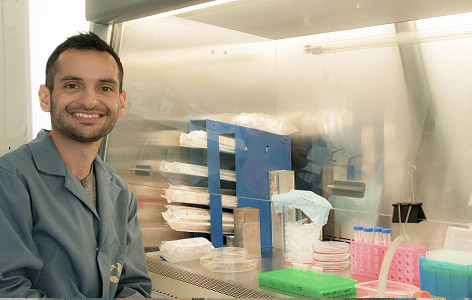
By Shaalee Dworski, ORT Times Writer and UHN Trainee
Identifying cancer cells is the first step in several approaches to treatment, including chemotherapy and immunotherapy. The ideal cancer cell identification marker is an extracellular protein that participates in essential functions of the cancer cell, but is less important or abundant in non-cancerous cells. However, tumours contain a complex set of diverse cells and cannot usually be discerned by a single marker. Similarly, when a potent target is found it may not be accessible for treatment.
Dr. Mauricio Medrano, a postdoctoral fellow in the laboratory of Dr. Robert Rottapel, and colleagues used a double-pronged approach to identify candidate ovarian cancer targets.
Ovarian cancer is the fifth most deadly cancer in women, with a 5-year survival of 46%. The lifetime risk for ovarian cancer is 1 in 75, and 1 in 100 women will die from the disease.
Seventy percent of ovarian cancer cases are of high-grade serous ovarian carcinoma (HGSC). The majority of HGSCs originate in the fallopian tube and spread early to the ovaries. Many cases are not diagnosed until the cancer is in an advanced stage. The 5-year survival rate of women with HGSC is 30%, and patients with certain subset of cells have the worst outcome.
To identify HGSC targets Dr. Medrano and colleagues screened patient-derived HGSC cell lines using two different libraries: an RNA interference (RNAi) library to identify genes essential for survival and growth, and an antibody library to identify cell surface proteins that are present on a majority of cells and are overexpressed in cancer cells. The integration of these two screens identified CD151 as a critical cell surface protein in HGSC.
When the authors looked at the outcomes of patients with HGSC tumours, high CD151 expression was associated with poor prognosis. This may be because tumour cells that express high levels of CD151 are most similar to the HGSC subtype with the poorest prognosis. Biologically, CD151 is needed for the survival and migration of cancer cells and supports tumour initiation and maintenance in an in vivo experimental model.
Future therapies that target CD151 may be able to benefit patients with the most lethal forms of ovarian cancer.
The ORT Times spoke with the first author, Dr. Medrano.
1. Is CD151 targeted in other cancers?
CD151 is involved in cell adhesion, migration, invasion, and metastasis in a number of different cancers. However, its role in directly contributing to cell survival, which we identified in our study, was not previously known. As a marker for poor prognosis, CD151 has been implicated in numerous human cancers including breast, pancreatic, hepatocellular, and others.
2. What are your next steps to taking this to the clinic?
To develop CD151 as a therapeutic target we would develop antibodies that recognize CD151 on the cell surface and test their ability to target cancer cells in experimental models. Another parallel approach is to identify proteins that assist CD151 and target those molecules to shut down the signalling pathway.
For CD151 to have clinical impact as a marker for poor prognosis, we would expand our studies using larger patient cohorts, and show that CD151 is reliably more predictive of outcome than the current best models. This could help us identify patients that are likely to have the most aggressive cancers.




